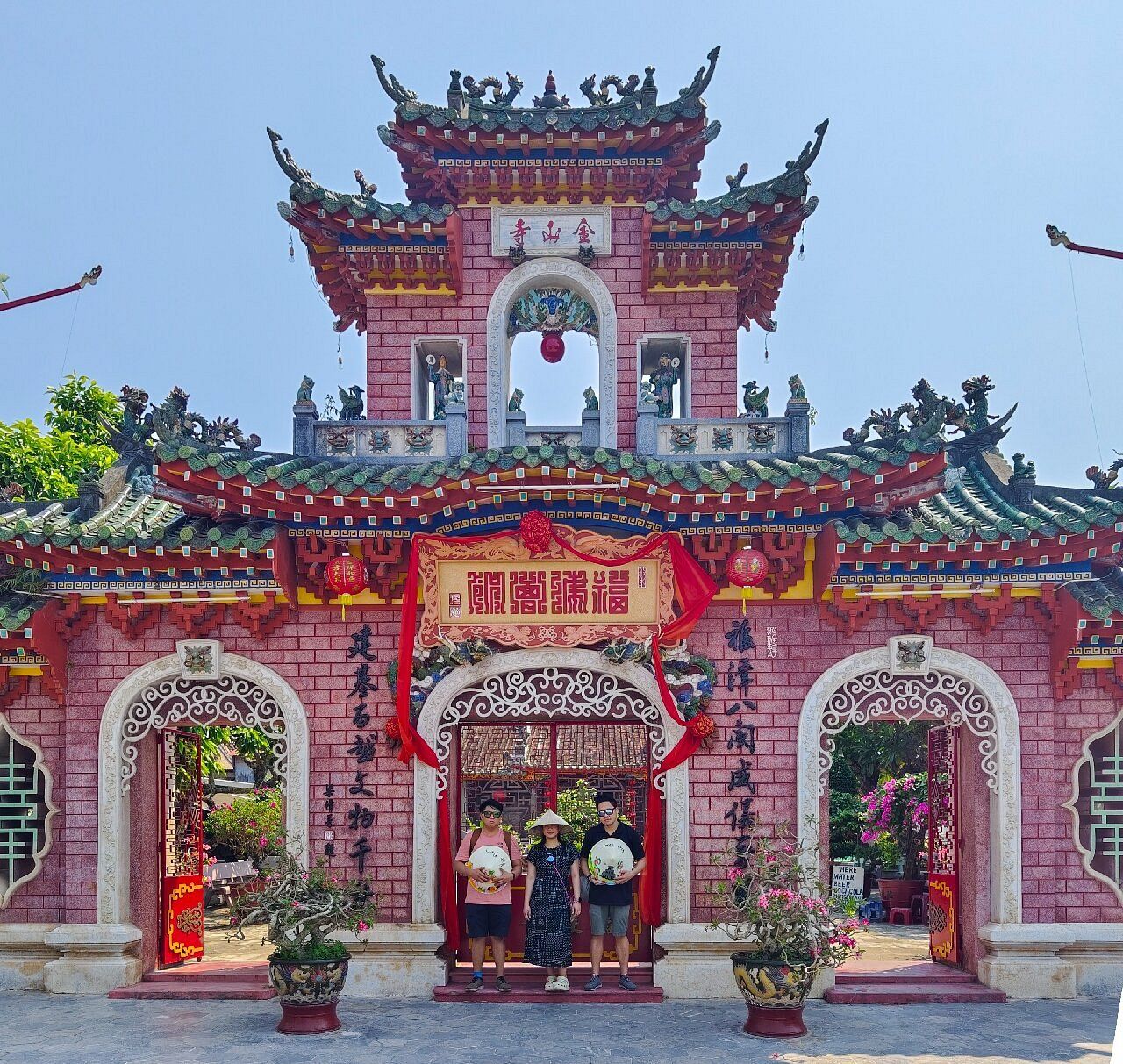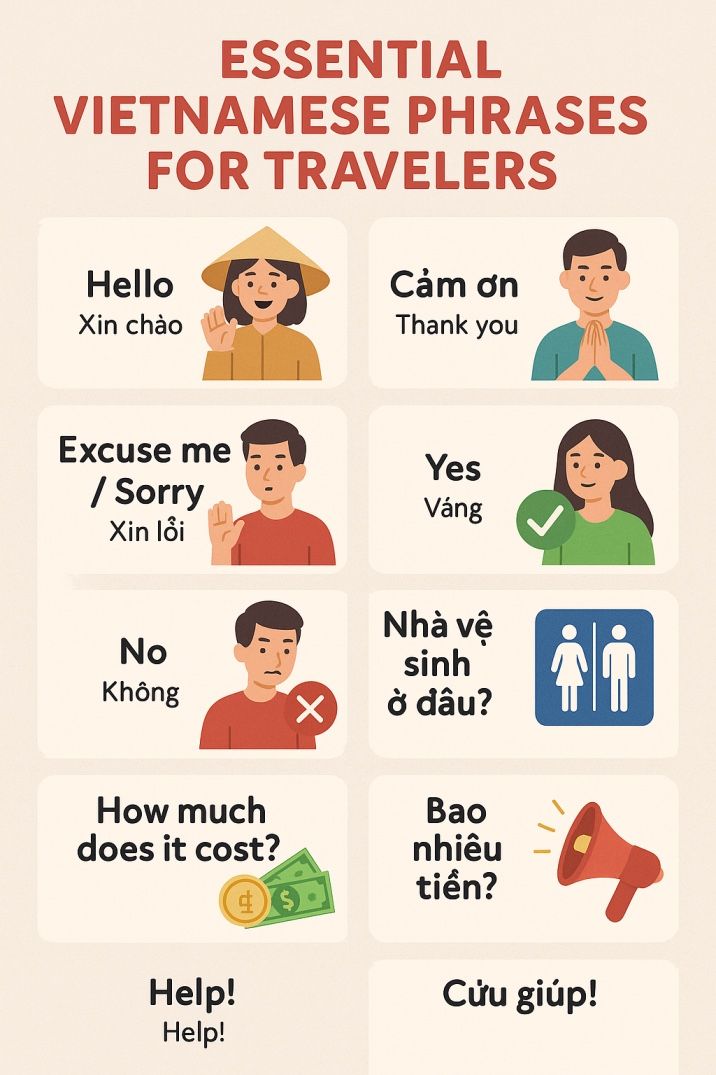Essential Vietnamese Phrases and Greetings words Every Tourist Should Know: Whether you explore local markets or meet friendly locals, these phrases help you connect. Say “Xin chào” (Hello), “Chào buổi sáng” (Good morning), “Chào buổi tối” (Good evening), or “Chào anh/chị/em” to greet people politely. Use “Tạm biệt” (Goodbye), “Hẹn gặp lại” (See you again), “Cảm ơn” (Thank you), and “Xin lỗi” (Sorry/Excuse me) to handle everyday interactions confidently during your Vietnamese adventure.
Useful Vietnamese words and phrases to learn
This post is a guide to an essential Vietnamese phrases and most useful words that every tourist should know before visiting.
Learning at least a few words in Vietnamese not only shows respect for the local culture but also helps break the ice more easily when you travel across Vietnam. In addition, exploring languages like Vietnamese and familiarizing yourself with basic pronunciations can further enrich your overall experience, especially if you’re visiting more remote areas where nobody speaks English.
Fortunately, in most major tourist areas and resorts, locals usually speak some English, so you likely won’t face any serious communication problems. However, if you do encounter language barriers, just smile and embrace the situation as a natural and often memorable part of traveling.
- Check out Best things to do in Vietnam
Introduction to Vietnamese Language
The Vietnamese language (kinh) is a hybrid of Mon-Khmer, Tai and Chinese elements with many of its basic words derived from the monotonic Mon-Khmer languages. The most widely spoken foreign languages in Vietnam are English, Chinese (Cantonese and Mandarin), French and Russian, more or less in that order.
The pronunciation in Vietnamese language varies depending on each region. Moreover, Vietnam consists of three main regions—The North, The Central, and The South—and each one has its own unique pronunciation characteristics.
These differences contribute to the richness and distinctiveness of Vietnamese culture. To truly explore the beauty of these three regions, you need to pay close attention to how pronunciation reflects their individual identities.
Is it difficult to learn Vietnamese Phrases to travel?
Yes and No! Vietnamese is a tonal language, so various methods exist to transliterate Vietnamese into English. For example, you might see the Vietnamese word for ‘hello’ written as chao, xin chào, or chào ban. To help you prepare for your upcoming trip to Vietnam, we’ve gathered some useful Vietnamese phrases for you to learn.
Essential Vietnamese phrases to learn
These distinctions make Vietnamese words and phrases more specific and, requiring learners to pay closer attention to context when addressing others.
| English | Vietnamese |
|---|---|
| Thank you | Cảm ơn |
| Hello / Goodbye | Xin chào / Tạm biệt |
| How are you? | Bạn khỏe không? |
| I’m fine, thank you | Tôi khỏe, cảm ơn |
| What is your name? | Tên bạn là gì? |
| My name is | Tôi tên là … (nam: tôi là / nữ: tôi là) |
| Pleased to meet you | Rất vui được gặp bạn |
| You’re welcome | Không có gì |
| Good luck | Chúc may mắn |
| No problem / It’s nothing | Không sao đâu |
| Fun / Enjoyment | Vui vẻ / Thích thú |
| It’s fun / I’m enjoying this | Rất vui / Tôi đang tận hưởng điều này |
| Comfortable | Thoải mái |
| Very comfortable / Really relaxed | Rất thoải mái / Thư giãn |
| Excuse me / Sorry | Xin lỗi |
| Pardon? | Xin nhắc lại? |
| Toilet | Nhà vệ sinh |
| Where is the toilet? | Nhà vệ sinh ở đâu? |
| Understand | Hiểu |
| Don’t understand | Không hiểu |
Numbers in Vietnamese
| English | Vietnamese Numbers |
|---|---|
| 0 | Không |
| 1 | Một |
| 2 | Hai |
| 3 | Ba |
| 4 | Bốn |
| 5 | Năm |
| 6 | Sáu |
| 7 | Bảy |
| 8 | Tám |
| 9 | Chín |
| 10 | Mười |
| 20 | Hai mươi |
| 50 | Năm mươi |
| 100,000 | Một trăm nghìn |
| 500,000 | Năm trăm nghìn |
| 1,000,000 | Một triệu |
Compliment phrases in Vietnamese
| English Phrase | Vietnamese Translation |
|---|---|
| It’s good! | Nó rất tốt! (No rat tot!) |
| It is beautiful! | Đẹp quá! (Dep qua!) |
| I like it! | Tôi rất thích! (Toi rat thich!) |
| You are so beautiful! | Bạn rất đẹp! (Ban rat dep!) |
| The food is so delicious! | Món ăn rất ngon! (Mon an rat ngon!) |
Vietnamese Phrases for foods & drinks: At the restaurant
| English | Vietnamese Phrases |
|---|---|
| Have you eaten yet? | Bạn ăn cơm chưa? (Ban an com chua?) |
| What do you have that’s special? | Bạn có món gì đặc biệt? (Ban co mon gi dac biet?) |
| I’m vegetarian (male) | Tôi ăn chay (Toi an chay) |
| I’m vegetarian (female) | Tôi ăn chay (Toi an chay) |
| Normal portion | Phần bình thường (Phan binh thuong) |
| Special/Large portion | Phần đặc biệt (Phan dac biet) |
| Take-away/Take home | Mang về (Mang ve) |
| Menu | Thực đơn (Thuc don) |
| Can I have the bill? | Tính tiền giúp tôi (Tinh tien giup toi) |
| Delicious | Ngon (Ngon) |
| Very delicious | Rất ngon (Rat ngon) |
| Spicy | Cay (Cay) |
| Not spicy | Không cay (Khong cay) |
| A little bit spicy | Cay một chút (Cay mot chut) |
| Beef | Thịt bò (Thit bo) |
| Chicken | Thịt gà (Thit ga) |
| Duck | Thịt vịt (Thit vit) |
| Pork | Thịt heo / Thịt lợn (Thit heo / Thit lon) |
| Vegetables | Rau (Rau) |
| Big/Wide noodles | Phở to / Bánh phở bản to (Pho to / Banh pho ban to) |
| Small/Thin noodles | Bún / Miến (Bun / Mien) |
| Fruit | Trái cây / Hoa quả (Trai cay / Hoa qua) |
| Water | Nước (Nuoc) |
| Ice | Đá (Da) |
| Bowl | Tô / Bát (To / Bat) |
| Plate | Đĩa (Dia) |
| Spoon | Muỗng / Thìa (Muong / Thia) |
| Fork | Nĩa / Dĩa (Nia / Dia) |
| Chopsticks | Đũa (Dua) |
Shopping and Bargaining phrases
| English | Vietnamese phrases |
|---|---|
| How much is it? | Cái này bao nhiêu? (Cai nay bao nhieu?) |
| I want this! | Tôi muốn cái này! (Toi muon cai nay!) |
| It’s too expensive! | Đắt quá! (Dat qua!) |
| I’ll take it! | Tôi lấy nó! (Toi lay no!) |
| I want the smaller one. | Tôi muốn cái nhỏ hơn. (Toi muon cai nho hon.) |
| I want the bigger one. | Tôi muốn cái lớn hơn. (Toi muon cai lon hon.) |
| Do you have a discount? | Có giảm giá không? (Co giam gia khong?) |
| Can I try it on? | Tôi có thể thử không? (Toi co the thu khong?) |
| Can I pay by card? | Tôi có thể trả bằng thẻ không? (Toi co the tra bang the khong?) |
Polite & Formal Talk in Vietnamese
When speaking Vietnamese, it is extremely important to add the polite particle ‘ạ’ at the end of a sentence. In formal or respectful conversations, Vietnamese speakers commonly include polite words like “dạ” (yes, politely) or “ạ” to show respect, especially when speaking to elders or superiors.
Although Vietnamese has a word for please (such as “làm ơn”), people don’t use it as frequently or in the same way as in English. Instead, they usually express politeness through tone, respectful pronouns, and particles like “ạ” or “dạ.”
Different Vietnamese Accents Across the Three Regions
The information below explains how pronunciation and word usage differ across Vietnam and highlights the unique features of each region’s accent.
Northern Vietnamese Accent
In Northern Vietnam, locals tend to pronounce words with a heavier and clearer tone. For instance, they often pronounce the letters “l” and “n” distinctly, and they usually pronounce the letters “gi,” “d,” and “r” as the same sound and tonation.
This characteristic makes the Northern Vietnamese accent relatively consistent and standard, especially in formal settings and media.
Central Vietnamese Accent
In Central Vietnam, people often change the tone marks in their pronunciation. For example, they may pronounce acute accents as grave accents, and underdot tones as grave accents.
This shift gives the Central Vietnamese accent a distinctive and sometimes harder-to-understand quality for those unfamiliar with it.
Southern Vietnamese Accent
In Southern Vietnam, people typically pronounce the letter “gi” the same way they pronounce “d.” Additionally, they often merge the tilde accent with the hook above accent, making the Southern Vietnamese accent more relaxed and fluid in tone.
Moreover, each region uses different local words to refer to the same objects. This variation in vocabulary, along with pronunciation differences, adds to the richness and diversity of the Vietnamese language.
Key Differences in Addressing People in English vs. Vietnamese
When speaking English, people usually use the same pronouns such as “I,” “you,” “he,” and “she” regardless of age, status, or relationship.
However, in Vietnamese, we choose from a wide range of pronouns based on the other person’s age, gender, social status, and level of familiarity.
For instance, they might say “bác,” “chú,” “cô,” or “dì,” depending on whether the person is older or younger than one’s parents, or whether the relationship is through the mother’s or father’s side.
Learn Vietnamese phrases to help you sound like a local
We hope this article has helped, but the best way to learn is by listening to native Vietnamese speakers and learning from them. If you get talking to staff at your hotel in Hanoi or Ho Chi Minh City, you will probably find they are more than happy to give you some advices.
Moreover, if you’re serious about learning Vietnamese pronunciation and common phrases, you’ll find plenty of free and helpful resources on YouTube and language learning platforms. These tools can help you develop your listening skills, expand your vocabulary, and speak more naturally in real-life situations.



You May Also Like
Long Coc Tea Hills in Phu Tho: A Hidden Photography Spot Near Hanoi
Long Coc Tea Hills in Phu Tho is a breathtaking hidden gem in northern Vietnam, ...
The Ultimate Guide For Visiting Visit Vietnam In February: Weather, Festivals & Itineraries
Imagine walking through Hanoi’s Old Quarter as peach blossoms bloom in doorways, or sitting by ...
Toilets in Vietnam: A Traveler’s Guide for Squat Toilets, Public Bathrooms & Flushing Paper
Let’s be honest—when you travel, toilets matter more than you expect. In Vietnam, they quickly ...
20 Traditional Vietnamese Folk Games
Traditional folk games in Vietnam are more than just childhood pastimes. They are the living, ...
How to Register a Company in Vietnam (2026 Guide)
Foreign investors planning to do business in Vietnam face a multifaceted legal system and bureaucratic ...
Visiting Vietnam in January 2026: Weather, Costs, Festivals & Travel Tips
I visited Vietnam in January 2026, and I still remember the crisp, cool air in ...